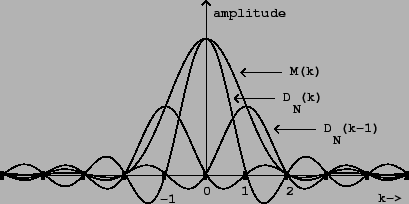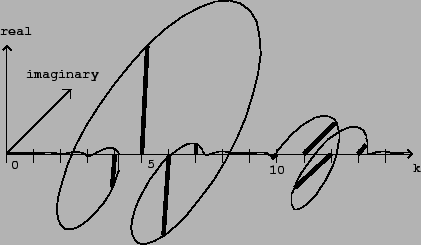Most signals aren't periodic, and even a periodic one might have an unknown
period. So we should be prepared to do Fourier analysis on signals without the
comforting assumption that the signal to analyze repeats at a fixed period ![]() .
Of course, we can simply take
.
Of course, we can simply take ![]() samples of the signal and make it
periodic; this is essentially what we did in the previous section, in which a
pure sinusoid gave us the complicated Fourier transform of Figure
9.3, part (b).
samples of the signal and make it
periodic; this is essentially what we did in the previous section, in which a
pure sinusoid gave us the complicated Fourier transform of Figure
9.3, part (b).
However, it would be better to get a result in which the response to a pure
sinusoid were better localized around the corresponding value of ![]() . We
can accomplish this using the enveloping technique shown in Figure
2.7 (page
. We
can accomplish this using the enveloping technique shown in Figure
2.7 (page ![]() ). Applying this technique to Fourier
analysis will not only improve our analyses, but will also shed new light on
the enveloping looping sampler of Chapter 2.
). Applying this technique to Fourier
analysis will not only improve our analyses, but will also shed new light on
the enveloping looping sampler of Chapter 2.
Given a signal x[n], periodic or not, defined on the points from ![]() to
to ![]() ,
the technique is to envelope the signal before doing the Fourier analysis.
The envelope shape is known as a
window function.
Given a window function
,
the technique is to envelope the signal before doing the Fourier analysis.
The envelope shape is known as a
window function.
Given a window function ![]() , the
windowed Fourier transform
is:
, the
windowed Fourier transform
is:
 |
The main lobe of ![]() is four harmonics wide, twice the width of the
main lobe of the Dirichlet kernel. The sidelobes, on the other hand, have
much smaller magnitude. Each sidelobe of
is four harmonics wide, twice the width of the
main lobe of the Dirichlet kernel. The sidelobes, on the other hand, have
much smaller magnitude. Each sidelobe of ![]() is a sum of three sidelobes
of
is a sum of three sidelobes
of ![]() , one attenuated by
, one attenuated by ![]() and the others, opposite in sign,
attenuated by
and the others, opposite in sign,
attenuated by ![]() . They do not cancel out perfectly but they do cancel out
fairly well.
. They do not cancel out perfectly but they do cancel out
fairly well.
The sidelobes reach their maximum amplitudes near their midpoints, and we
can estimate their amplitudes there, using the approximation:
This implies that applying a Hann window will allow us to isolate sinusoidal components from each other better in a Fourier transform (than if no Hann window is applied.) If a signal has many sinusoidal components, the sidelobes engendered by each one will interfere with the main lobe of all the others. Reducing the amplitude of the sidelobes reduces this interference.
 |
Figure 9.6 shows a Hann-windowed Fourier analysis of a signal with
two sinusoidal components. The two are separated by about 5 times the
fundamental frequency ![]() , and for each we see clearly the shape of the
Hann window's Fourier transform. Four points of the Fourier analysis lie
within the main lobe of
, and for each we see clearly the shape of the
Hann window's Fourier transform. Four points of the Fourier analysis lie
within the main lobe of ![]() corresponding to each sinusoid. The amplitude
and phase of the individual sinusoids are reflected in those of the
(four-point-wide) peaks. The four points within a peak which happen to fall at
integer values
corresponding to each sinusoid. The amplitude
and phase of the individual sinusoids are reflected in those of the
(four-point-wide) peaks. The four points within a peak which happen to fall at
integer values ![]() are successively one half cycle out of phase.
are successively one half cycle out of phase.
To fully resolve the partials of a signal, we should choose an analysis size
![]() large enough so that
large enough so that ![]() is no more than a quarter of the
frequency separation between neighboring partials. For a periodic signal, for
example, the partials are separated by the fundamental frequency. For the
analysis to fully resolve the partials, the analysis period
is no more than a quarter of the
frequency separation between neighboring partials. For a periodic signal, for
example, the partials are separated by the fundamental frequency. For the
analysis to fully resolve the partials, the analysis period ![]() must be
at least four periods of the signal.
must be
at least four periods of the signal.
In some applications it works to allow the peaks to overlap as long as the center of each peak is isolated from all the other peaks; in this case the four-period rule may be relaxed to three or even slightly less.